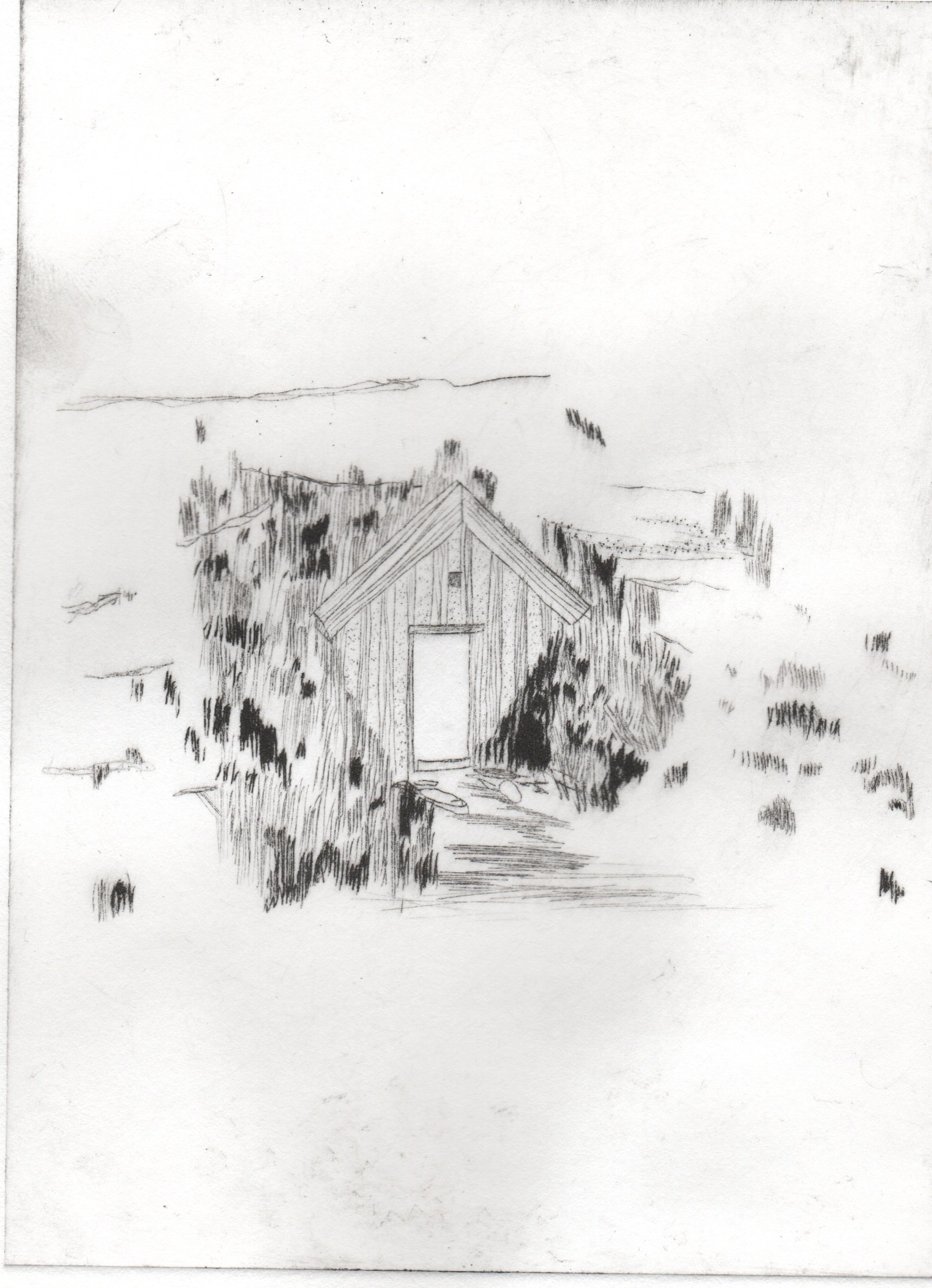Vers la cabane
« L'homme primitif a arrêté son chariot, il décide qu'ici sera son sol. Il choisit une clairière, il abat les arbres trop proches, il aplanit le terrain alentour; il ouvre le chemin qui le reliera à la rivière ou à ceux de sa tribu qu'il vient de quitter; il fonce les piquets qui retiendront sa tente. Il entoure celle-ci d'une palissade dans laquelle il ménage une porte. Le chemin est aussi rectiligne que le lui permettent ses outils, ses bras et son temps. Les piquets de sa tente décrivent un carré, un hexagone ou un octogone. La palissade forme un rectangle dont les quatre angles sont égaux, sont droits. La porte de la hutte ouvre dans l'axe de l'enclos et la porte de l'enclos fait face à la porte de la hutte.» Le Corbusier, (Vers une architecture, éditions G Cres, 1923, Paris, Flammarion, 2005, p.53).
«Primitive man has brought his chariot to a stop, he decides that here shall be his native soil. He chooses a glade, he cuts down the trees which are too close, he levels the earth around; he opens up the road which will carry him to the river or to those of his tribe whom he has just left; he drives in the stakes which are to steady his tent. He surrounds this tent with a palisade in which he arranges a doorway. The road is as straight as he can manage it with his implements, his amrs and his time. The pegs of his tent describe a square, a hexagon or an octogon. The palisade forms a rectangle whose four angles are equal. The door of his hut is on the axis of the enclosure-and the door of the enclosure faces exactly the door of the hut.» Le Corbusier (Towards a new architecture, translated by Frederick Etchells, Dover publication, New York, 1986 p.70).
Mausolée Abraham Lincoln
Kentucky, Etats Unis,1809
Cabanon Le corbusier
RoqueBrune-cap-Saint-Martin, France 1952
Sanctuaire d’Ise,
Japon, 2013
Cabane, Henry David Thoreau, Massachusetts
Etats Unis 1844
La cabane porte en elle une des première opposition de l’architecture: entre le temple et l’abri. C’est une figure symbolique et performative. Il y aurait quatre type de huttes/cabanes:
-La Cabane historique, laissé derrière en construisant des cabanes de mieux en mieux, the meliora genera casarum de Vitruve.
-La Cabane revisité dans notre imaginaire pour faire une comparaison avec les maison sursophistiqué. C’est la petite cabane rustique de Marc Antoine Laugier.
-La Cabane Anthropologique, Qui existe actuellement dans une société non occidentale, préindustrielle. La cabane en Bambou des caraïbe de Gottfried Semper.
-La Cabane primitive de Ryckwert comme un événement continue, quelquechose qui apparait chaque fois que l’on fait un lieu pour nous ou construire un édifice qui est en même temps naïf et consciemment sophistiqué.
The cabin is representing one of the first opposition of the Architecture: between the temple and the shelter. It is a symbolic and a performative figure. There would be four types of huts/cabins:
-The historical cabin, left behind by building cabins becoming always better, it is the meliora genera casarum of Vitruvius.
-The cabin that we revisit in our imaginary that we compare with the over sophisticated houses. It is the small Rustic cabin of Marc Antoine Laugier.
-The anthropological cabin that is actually existing in a non occidental and pre-industrial society. The Caribbean cabin in bamboo of Gottfried Semper.
-The primitive cabin of Ryckwert like a continuous event, something that appears every time that we create a place for us or an edifice that is at the same time naive and conscientiously sophisticated.
Chalet Alpin
Suisse, 1955
Sauna Villa Mairea, Alvar Aalto,
Finlande, 1939
Cabane de gardians, Camargue
France, 1900
Bergerie,
Islande, 1990
Elle révèle ainsi un rapport au monde établi par les hommes et leur environnement. Une interface témoignant leurs techniques, leurs cultures, la vision qu’ils ont de leur territoire, de leur société, leur rapport au site, à la terre, aux matériaux, à la géographie. La cabane est donc à considérer comme une manifestation du faire mais aussi de l’être. La cabane est ainsi vue comme un liant permettant une lecture et la construction d’un territoire, d’une culture, à l’articulation entre artisanat et architecture. Les cabanes répondent à un besoin de l’homme se plaçant comme un marqueur dans un territoire. La cabane de pêche au bord des étangs, la cabane de chasse en forêt ou la cabane de berger dans les alpages sont toute porteuse d’un mode de vie et réponde à un besoin pour un territoire donné.
It reaveals a relation it’s the world established by men and their environment. An interface showing their technics, their culture, the vision they have of their territory of their society, their relation to the site, to the ground, the materials, the geography. The cabin is therefore to consider as a manifestation of the making, but also of the being. Thus, the cabin is perceived as a binder permitting the reading and the building of a territory, a culture, at the articulation between architecture and craftsmanship. The cabin answer to the need of men by being a marker in a territory. The fishing cabin beside a lake, the hunting cabin in the forest or the shepherd’s cabin in the pasture are all a representation of a way of living and answer to a need in a given territory.
Cabane de pêche
France, 1960
Cabane de Richard Proenneke,
Alaska, Etats-Unis 1985
Craftsman Farms, Gustav Stickley,
New Jersey, Etats-Unis, 1907
Pavillon Niels Bohr, résidence d’été, Vilhem Wohlert,
Danemark, 1957

















